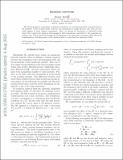Files in this item
Quantum conversion
Item metadata
| dc.contributor.author | Mazilu, Michael | |
| dc.date.accessioned | 2017-04-28T09:30:15Z | |
| dc.date.available | 2017-04-28T09:30:15Z | |
| dc.date.issued | 2015-08-05 | |
| dc.identifier.citation | Mazilu , M 2015 ' Quantum conversion ' . < http://arxiv.org/abs/1508.01178v2 > | en |
| dc.identifier.other | PURE: 249879205 | |
| dc.identifier.other | PURE UUID: ca6e0631-c2cb-4544-a10a-a56a45a36e70 | |
| dc.identifier.other | ArXiv: http://arxiv.org/abs/1508.01178v2 | |
| dc.identifier.uri | https://hdl.handle.net/10023/10677 | |
| dc.description | ICOAM 2015 | en |
| dc.description.abstract | The electromagnetic momentum transferred transferred to scattering particles is proportional to the intensity of the incident fields, however, the momentum of single photons ℏk does not naturally appear in these classical expressions. Here, we discuss an alternative to Maxwell's stress tensor that renders the classical electromagnetic field momentum compatible to the quantum mechanical one. This is achieved through the introduction of the quantum conversion which allows the transformation, including units, of the classical fields to wave-function equivalent fields. | |
| dc.format.extent | 2 | |
| dc.language.iso | eng | |
| dc.rights | Copyright the Author 2015. | en |
| dc.title | Quantum conversion | en |
| dc.type | Working or discussion paper | en |
| dc.description.version | Publisher PDF | en |
| dc.contributor.institution | University of St Andrews. School of Physics and Astronomy | en |
| dc.identifier.url | http://arxiv.org/abs/1508.01178v2 | en |
This item appears in the following Collection(s)
Items in the St Andrews Research Repository are protected by copyright, with all rights reserved, unless otherwise indicated.

